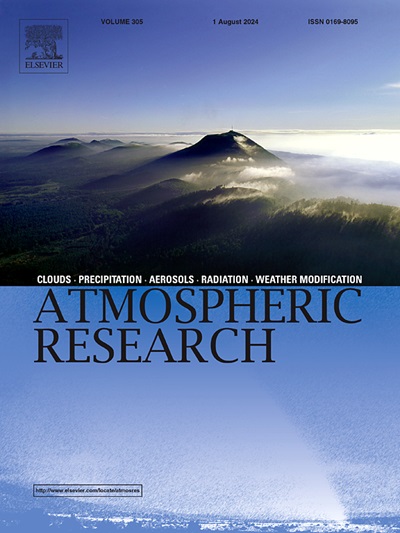Understanding the driving mechanism for heat waves variability over South Asia during El Niño and La Niña events
IF 4.5
2区 地球科学
Q1 METEOROLOGY & ATMOSPHERIC SCIENCES
引用次数: 0
Abstract
This study focuses on heat waves (HWs) variability over South Asia (SA) influenced by El Niño Southern Oscillation (ENSO) during 1950–2023. The influence factor and driving mechanism for HWs variability over SA in the El Niño and La Niña years are discussed. We observe positive composite anomalies of HWs events and frequency over the north-western region of SA in La Niña years but negative composite anomalies in El Niño years. In La Niña years, outgoing long-wave radiation (total cloud cover) over the north-western region of SA has positive (negative) anomalies. Thus, less cloud cover regions allow more solar radiation to increase the surface temperature and HWs. During La Niña years, positive composite anomalies of HWs over the north-western region of SA are mainly due to positive anomalies of outgoing long wave radiation, negative anomalies of total cloud cover, positive anomalies of soil temperature level 1, negative anomalies of relative humidity, positive anomalies of short-wave radiation and negative anomalies of long-wave radiation. However, during El Niño years, negative composite anomalies of HWs over the north-western region of SA are due to negative anomalies of outgoing long wave radiation, positive anomalies of total cloud cover, and negative anomalies of direct solar radiation. During El Niño years, vertical-latitude cross-section and vertical-longitude cross-section analysis show significant positive anomalies of air temperature, positive anomalies of vertical velocity, negative anomalies of relative humidity, and positive anomalies of geopotential height; support increases in the HWs over the southern and central -eastern region of SA. These findings give important insights into how future weather patterns may evolve during ENSO events and can contribute to early forecasting and making heat wave adaptation strategies.
了解El Niño和La Niña事件期间南亚热浪变率的驱动机制
本文研究了El Niño南方涛动(ENSO)对1950-2023年南亚地区热浪(HWs)的影响。讨论了El Niño和La Niña年暖波变率的影响因素和驱动机制。在La Niña年,在SA西北地区观测到HWs事件和频率的正复合异常,而在El Niño年观测到负复合异常。La Niña年,SA西北地区的长波辐射(总云量)呈正(负)异常。因此,较少的云覆盖区域允许更多的太阳辐射来增加地表温度和高温。La Niña年期间,SA西北地区HWs的正复合异常主要是由于出射长波辐射正异常、总云量负异常、土壤温度1级正异常、相对湿度负异常、短波辐射正异常和长波辐射负异常。而在El Niño年期间,SA西北地区HWs的负复合异常是由于出射长波辐射的负异常、总云量的正异常和太阳直射辐射的负异常。El Niño年垂直纬度剖面和垂直经度剖面分析显示气温正异常、垂直速度正异常、相对湿度负异常和位势高度正异常显著;新南威尔士州南部和中东部地区的HWs支持增加。这些发现为了解ENSO事件期间未来天气模式如何演变提供了重要见解,并有助于早期预报和制定热浪适应策略。
本文章由计算机程序翻译,如有差异,请以英文原文为准。
求助全文
约1分钟内获得全文
求助全文
来源期刊

Atmospheric Research
地学-气象与大气科学
CiteScore
9.40
自引率
10.90%
发文量
460
审稿时长
47 days
期刊介绍:
The journal publishes scientific papers (research papers, review articles, letters and notes) dealing with the part of the atmosphere where meteorological events occur. Attention is given to all processes extending from the earth surface to the tropopause, but special emphasis continues to be devoted to the physics of clouds, mesoscale meteorology and air pollution, i.e. atmospheric aerosols; microphysical processes; cloud dynamics and thermodynamics; numerical simulation, climatology, climate change and weather modification.
 求助内容:
求助内容: 应助结果提醒方式:
应助结果提醒方式:


